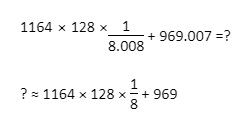In the examination, the questions based on simplification can increase your score as by just applying basic regulations, you can get the answer. But the candidates should keep in mind to employ all the rules of BODMAS because without it, if you solve the question, then the entire effort will be in vain. You are just required to simplify the expression given and, step by step, apply the BODMAS rule.
Whereas in approximation questions, you need not solve the question to get the exact answer. Rather, you can leave the question on the approximate value.
It is suggested that you clearly solve the question and find the nearest value that is close to the suitable answer. Just don’t waste time in getting the to-the-point solution.
Variety of framed problem statements on the topic
The purpose of asking questions about approximation and simplification is to assess a candidate’s ability to work with numbers and perform simple arithmetic.
Big decimal numbers and computations may appear complex in the questions, yet this is one of the topics where a student can score the highest without making any mistakes.
There are two ways to pose simplification questions:
Find out the missing number:
In this, the candidates are required to fill in the incomplete equation with a suitable number that fits perfectly. A question may arise in the format that an expression will be given and its either right-hand side or the left-hand side will be blank, and you need to solve for the same
For example: 273 – 150 x 5 = 300 + _________
Simply the given expression:
In this type, the students have to just quickly solve the given equation, and there is no matter of RHS or LHS, just a well-framed expression will be provided, and you need to answer from the question mark placed at the blank.
For example: 450 x 98 + 132 – 78 =?
How to solve questions on this concept
There are several fundamental tips and tactics that may be employed to tackle the approximation and simplification challenges to ensure that the person does not drop marks on this topic. Let’s go through the following recommendations:
Always use the BODMAS rule to solve approximation or simplification questions.
If a number is provided in a decimal system, it is rounded off to the nearest whole number. For example, 46.62 can be read as 47, 12.11 as 12, and so on.
Learning tables of at least 20 can be quite beneficial to applicants and can help them save time.
Don’t make the questions too difficult, and make absolutely sure that complex calculations are omitted in order to compute the problems in a less amount of time.
The description below depicts the BODMAS rule, which is stated in the first statement of advice for simplification:
Let’s discuss the meaning of BODMAS
B stands for Brackets, and it is necessary to first solve the brackets and then proceed further
O stands for of
D depicts division, and after simplification of brackets, we have to solve the division query.
M in BODMAS describes the multiplication
A is for Addition
S denotes subtraction and should be solved at last
Candidates should seriously follow this rule for solving simplification and approximation queries.
Illustrations
Aspirants studying for upcoming enrollment for various competitive tests should be aware that competition is fierce and that the number of vacancies available is limited. As a result, the more a student practices, the better his or her chances of passing the exam.
A few sample questions are provided below to assist you to grasp the topic of simplification even better and to help applicants learn how to answer such problems correctly.
Example 1: (√624.75 – √168.80) × (√255.61 + √729.057) =?
A. 496
B. 501
C. 457
D. 516
E. 524
Solution: (√624.75 – √168.80) × (√255.61 + √729.057) =?
(√625 – √169) × (√256 + √729) =?
(25 – 13) × (16 + 27) =?
12 × 43 =?
? = 516
Hence, option D is correct.
Example 2: (25.03)2+ ( 16.93)2– (13.06)2= ? + 72 ÷ 9
A. 732
B. 739
C. 737
D. 763
E. 770
Solution:
(25.03)2 + (16.93)2– (13.06)2=? + 72 ÷ 9
≈ 625 + 289 – 169 – 8 =?
? = 914 – 177
? = 737
Hence, option C is correct.
Example 3: 1164 × 128 ÷ 8.008 + 969.007 = ?
A. 18700
B. 19600
C. 19900
D. 19500
E. 18900
Solution: By taking the approximate value for the expression, we have
1164 × 128 ÷ 8.008 + 969.007 = ?

? = 1164 × 16 + 969
? = 18624 + 969 = 19593 ≈ 19600
Hence, option B is correct.
Conclusion
To efficiently solve all the problems based on the simplification concept, you must follow the BODMAS rule. Without this, you will not be getting the right answer. It is found that whenever students attempt any such questions, they forget to apply the rule and proceed with solving the question in a general way based on the position of the operators.
But is it significant for the applicants to understand that even in approximation queries, they first need to properly go through the question and then carry on with the solution. Improper interpretation of the problem statement can lead to loss of marks.
 Profile
Profile Settings
Settings Refer your friends
Refer your friends Sign out
Sign out




